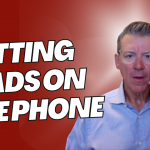ANSWER: It depends on when the product was created…
Have you ever been faced with these questions in your own business?
- “How do I increase my sales?”
- “What do I say in my ad that will make people call right away?”
If so, you could gain a lot of insight by understanding the lesson that is clearly demonstrated in the series of ads shown above.
The ads are for two well-respected corporations: Dell and Mercedes-Benz.
What do cars and computers
have in common?
Not much if you approach things in an ordinary fashion. An obvious difference would be price: computers cost hundreds of dollars, while a car costs tens of thousands. One product sits on your desk…the other on your driveway.
The first two ads on the left were used by each company in its early years, and the second set are current examples. Even though the two “products” appear to have nothing in common, note how similar the first two ads are. The layouts are similar and each is copy-dominant.
But look what happens in the second set of ads—they both rely on photos and graphics and there is almost no written information. At first blush, this seems a little confusing because one set of ads uses words to do the selling, but then it gets reversed and the entire pitch is communicated with pictures.
However, it all makes sense if you consider the ads in terms of life-cycle of a brand. Long ads—ones with lots of copy—are needed when a company or product is unknown. Long ads are helpful because information can be used to educate the consumers about what sets the product APART from the competition.
This is branding’s sole purpose—it tells consumers what makes you different. Dell was the first company to sell computers direct, and Mercedes was first to introduce a super luxury brand to the American market (when launched in this country, a Benz was twice the price of a Cadillac).
The question is not as simple as, “Does a long ad work better than a short ad?” The better question is whether you’re selling a new product or a well-known one.
What do these examples have to do with selling homes? A lot. As you’ll soon see.
Remember: Branding is nothing you do to the product…it is a perception that exists in the mind of the consumer. For example, if you stopped the average person on the street, he knows that “Blockbuster” means video rentals…that “Dominoes” delivers pizza…and that “eBay” stands for online auctions.
Long ads are well suited when you are building a brand. Short ads are fine for maintaining an established brand. At this point, Dell and Mercedes-Benz are household names so long ads are not needed.
What’s best for selling a house…
LONG or SHORT ads?
Because homesellers are too close to their situation, they often make a misstep when they put their homes on the market.
They know all about their home and what makes it special, and they assume prospective buyers will easily recognize its positive attributes. But the consumer has never seen any of the homes that are on the market. Buyers start with a blank slate. They will form an opinion about a home based on the marketing material they see.
Unfortunately, most houses end up being promoted with “me-too” real estate flyers that simply list boring statistical data such as:
- Bedrooms: 4, Baths: 3, Year Built: 1994, etc.
If you allow a house to be marketed with details that are COMMON to many other houses, it may never escape from obscurity. For example, houses in Westlake (an area outside Austin, Texas, where I sell homes) are often marketed with a theme that stresses the highly acclaimed Eanes School District. But why rely on a feature that is guaranteed to be available at every other Westlake house?
A seller may in fact have the best home in the neighborhood, but it may not make a difference if the consumer never gets the message.
When you set out to market a house, it tracks the same path as bringing a new product to market.
This means that houses are tailor-made for using long ads. Since no two houses are alike, there is always plenty of information you can communicate to the consumer. And you cannot bore consumers with straight facts.
It is better to use a “story ad”—ads that sell by telling an interesting story. In theory, holding an open house is a sound marketing idea because the consumer gets to use all of his senses to see the house and get a “feel” for the floorplan, the yard and the neighborhood.
But an open house may only produce a handful of people who walk through.
However, a well-written ad, that is widely circulated, has the effect of one voice speaking to thousands of potential buyers. The law-of-averages kicks in at this point, and your odds of finding the right buyer increase exponentially.
Here’s an example of a “story ad”…

(click the image to open the ad in a PDF)
This ad is an example of the type of message needed to bring a beautiful home to the forefront in a glut of inventory…
When the seller called me, this house in the Lakeway area of Austin had already been on the market for a year, and there were about 90 other “for sale” houses in the immediate area.
This home really was the best house in the neighborhood, and there was not a thing wrong with the seller’s price.
How do you get a prospective buyer interested
enough to come see your listing?
I wrote this long ad above that told about the home’s unique design, materials and lot. The seller got THREE offers, and the home sold in less than 30 days!
Here’s how I did it (and the same steps you can follow to sell your listings quicker):
STEP 1: Interview the seller on what made THEM interested in the house
STEP 2: Find your story-line by pulling out some of the unique benefits of the home from your research
STEP 3: Write a “story ad” that communicates the home’s difference
STEP 4: Place your ad in local publications where it will find the right buyer
Believe it or not, it really is that simple.
All kinds of excellent products fail in the marketplace because of weak, tame, and ineffective advertising. This includes homes when all that’s used is a traditional flyer to communicate a list of features.
Learn how to investigate what makes a home truly different than the others on the market. And then communicate that difference in a way that targets and benefits the potential buyer.
More examples to come in my next article…stay tuned!
[Ed note: Copyright Stan Barron. Reprinted with permission. If you, or someone you know wants to sell a house, please give Stan a call at 512-345-8585.]










